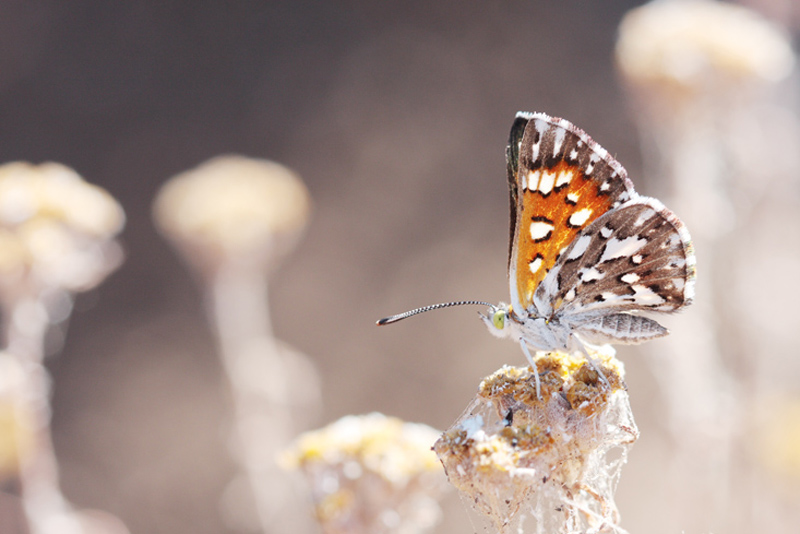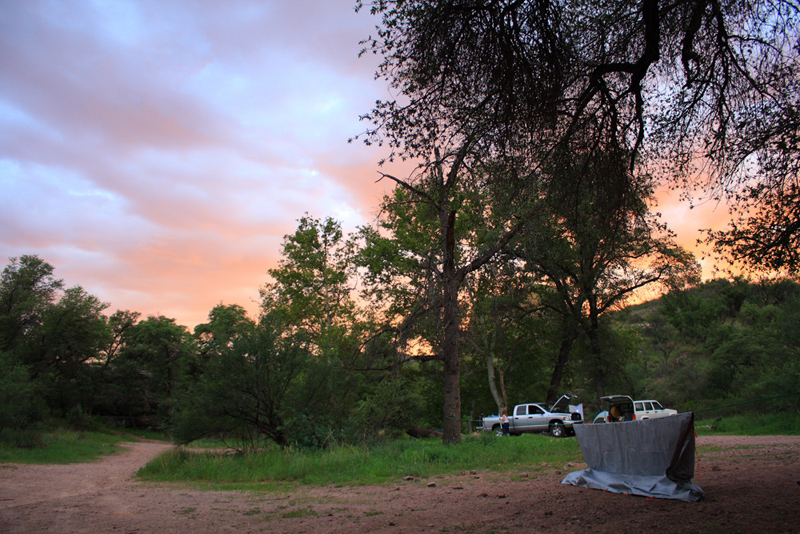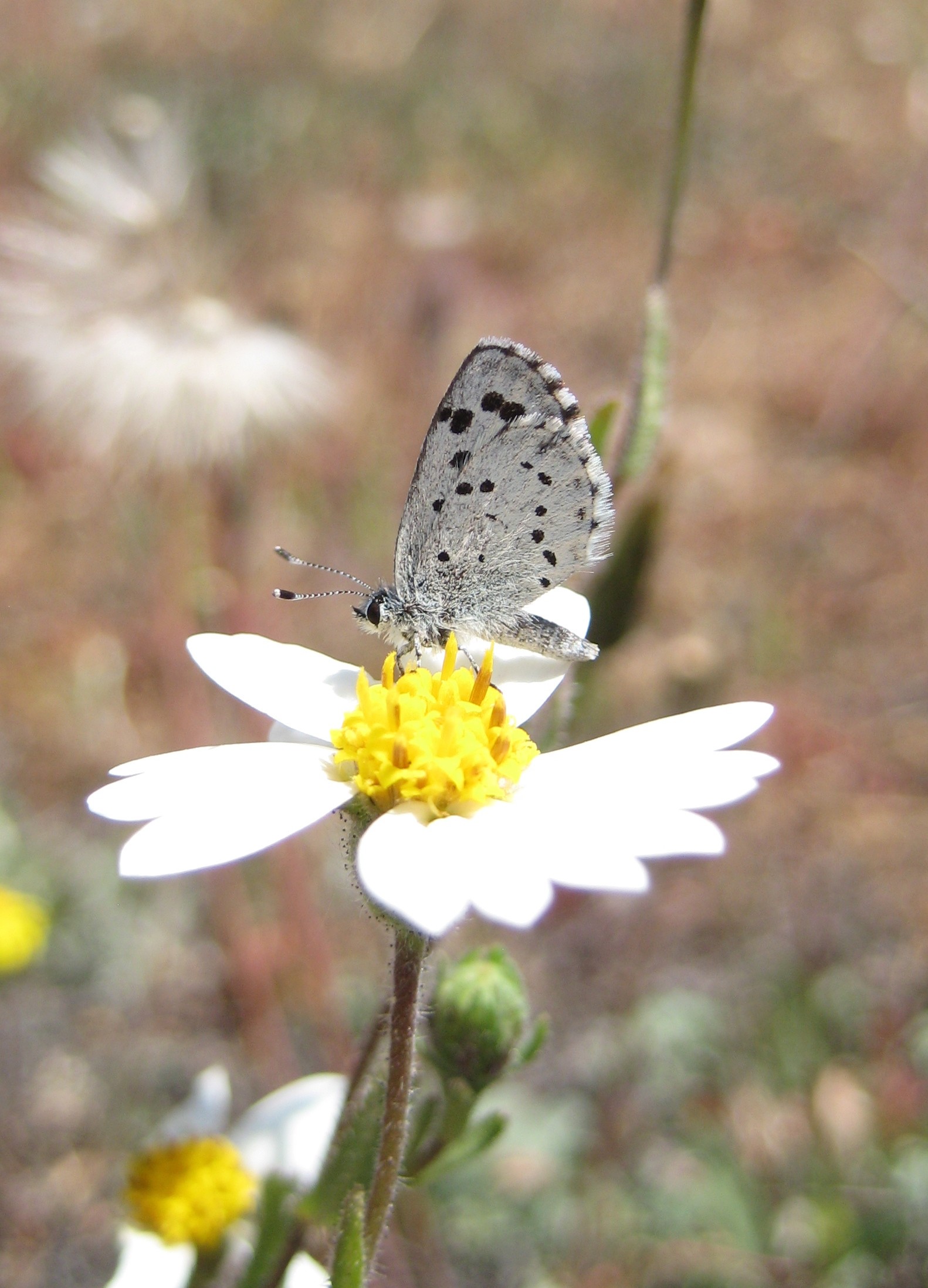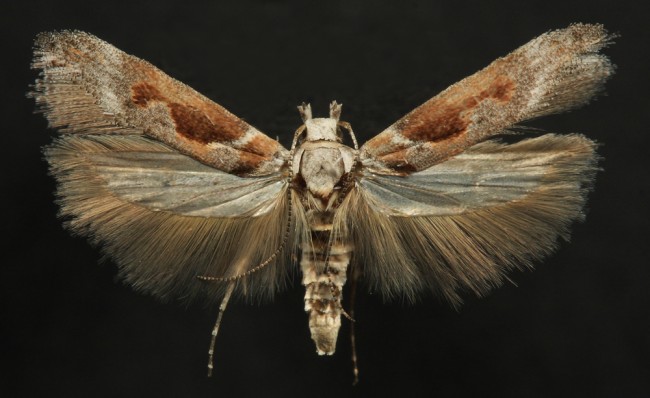Di Chris Grinter, on February 24th, 2010

Know this butterfly? It’s OK, no one really does. It is in the genus Apodemia (Riodinidae), ma la tassonomia di questo gruppo è un disastro… e non so nemmeno fatemi parlare della sottospecie. Questo esemplare è stato fotografato nel mese di settembre, che significa che è più probabile che sia Apodemia Mormo (Mormone) based on flight time. La. Mormone is a fall flyer and La. virgulti is a spring flyer. While some forms seem distinctive, there is massive morphological overlap and they are usually identical and sympatric – actually down to living on the same plants. But according to lab experiments it is impossible to get the pupae to break diapause so they remain reproductively isolated. So are they different? While molecular work is being conducted the verdict is out, but it does seem like these two species may be retained in the end. E, naturalmente,, each mountain range has it’s own subspecies. Who knows, I sure don’t. I’m glad I don’t work on butterflies.
Species concepts are a fuzzy line and it’s never clear exactly where to make the cut. When asked what a species is most people default to the Mayr concept of Biological Species (BSC), where reproductive isolation = new. This is all well and good but we have to keep in mind that this is not the ONLY species concept. Esistono dozens, and not one is perfect. Groups like Grammia (Noctuidae: Arctiinae) exhibit high levels of hybridization, which does not adhere well to the BSC. I like to apply as many criteria as possible to delimit a species and it seems like the line is all too commonly thin within insects. I like to see a distinguishing morphological trait, if not in wing color or pattern, at the least in the genitalia or antennae. This is not always the case however and you have to look at the biology and/or DNA. I have looked at two insects that are for all intents and purposes identical. But the biology is radically different and a large % difference (over 8% – sì, arbitrary) in their DNA makes it unquestionable that they are separate.
And if species weren’t contentious enough subspecies stir the pot even more. I’m skeptical about the entire concept, but there are cases in which it seems plausible and necessary. A subspecies is a more formal definition of a geographical “modulo” and usually exhibits a blend zone into another subspecies. For instance if you look at the 27 different populations of Plebejus icarioides there are large differences between northern and southern populations, but very subtile difference along the gradient. It is that persistent gradient that creates one dynamic species instead of 27 separate species – at least according to current research. Moths have been lucky and have thus far avoided the plague of over-subspeciation, butterflies not so much. There may even be instances where greedy collectors have named new subspecies of Parnassius for profit (new rare butterfly subspecies sell for big bucks).
The truth is that species concepts are artificial, poorly understood and dynamic at best; at worst it approaches a soft science with no real possibility of proof. Yet species are real and theories will continue to adapt while we sit here and scratch our heads.
Di Chris Grinter, il 23 febbraio, 2010 

Uno dei vantaggi di essere un entomologo è in viaggio e la raccolta. Ho messo qualche migliaio di chilometri sulla vettura ogni estate e questi sono due dei migliori posti in Arizona per raccogliere. L'immagine in alto è dalle montagne Baboquivari (Baboquivari picco nel mezzo), Stazione di ricerca Brown Canyon. The bottom image is of Pena Blanca Canyon, a famous collecting hotspot. This canyon is just 5 miles from Mexico and has a few safety concerns because of our current immigration policy. One morning, while sorting moths from the previous nights catch, a colleague and I had a group of roughly 30 illegals walk right through our camp. They were well dressed and clean, waved, and must have just been dropped off at the fence. Thankfully the majority of illegals are hard-working and honest people trying to earn a better life. It’s the coyotes and smugglers that are scarier – I have heard tales of Mexican police escorting drug caravans into the US with heavy artillery. And just last year a border patrol agent was stabbed to death by a coyote in this vicinity.
Per fortuna, a bunch of strange guys standing around strange lights at nights grants us a wide berth.
(Are these images small enough to load quickly?)
Di Chris Grinter, il 23 febbraio, 2010 Pur essendo abbastanza disinteressato farfalle, sono piuttosto a guardare. Qui è davvero un bellissimo video da un tizio che conosco giù nel sud della CA. I suoi video time-lapse del ciclo di vita lepidotteri sono piuttosto impressionanti, e questo in particolare è bellissimo. Se si taglia a circa 3:00 in, you will see dozens of Great Purple Hairstreaks (Atlides halesus) emerging from their chrysalises, the colors are stunning. This butterfly is native to the SW and Mexico, and I have to admit I love finding it in the field.
[youtube=http://www.youtube.com/watch?v=KyWJlpIchkE]
Di Chris Grinter, il 23 febbraio, 2010 The brief comment about Linus Pauling and Vitamin C below made me remember this video first posted a while ago by Pharyngula. Questo è Kary Mullis, l'inventore della PCR, e un Premio Nobel. La sua invenzione sostanzialmente reso possibile l'analisi del DNA. Ma come Pauling, egli è anche completamente e totalmente noci. If you have the time to listen to him ramble, give it a shot. Ma in breve, he discusses astrology, denies global warming and how AIDS is not caused by HIV. I wonder what the stats are for genius scientists that slide off their rocker?
[Vimeo 9167379]
Di Chris Grinter, il 22 febbraio, 2010 
Questa è una vecchia immagine del mio, quindi non è perfetto. Se potete dirmi questa farfalla di specie si ottiene un alto cinque. Se si conosce la sottospecie, Ti manderò una nuova confezione di #3 perni in acciaio inox! Solo accennare: E 'dagli Stati Uniti occidentali.
Di Chris Grinter, il 22 febbraio, 2010 Today I found Questo article in NY times health – propagandano i benefici di agopuntura utilizzati per alleviare la depressione nelle donne in gravidanza. Ho qualche problema con il giornalista, Shirley S. Wang, non riuscendo a rimanere scettici a suo pezzo. Ma questa non è una sorpresa, so I won’t bother to point out obvious flaws in the media.
I will point out the flaws in the study. Please find the original full text, qui. So after reading this paper I have come to a few conclusions.
1) Very small sample size of 150 patients, solo 141 treated.
2) The study is blinded ONLY for the depression scoring, not administration of acupuncture. In fact, their release form states “Participants in one of these two groups will receive acupuncture that focuses on depression symptoms and the other treatment will not.” Makes sense, getting a needle shoved in your skin is easy to notice. Così, these “randomized and blinded” participants knew what was coming and assumed that any poking was supposed to help their depression. Inoltre, Questo (much better) study has shown that simulated acupuncture with toothpicks works just the same. Careful, this is compelling evidence against the validity of acupuncture – not evidence for the usefulness of stimulated “pressure points”. It is a placebo effect.
3) Study assumes validity of “depression specific” e “non-specific” acupuncture. Meaning one method of pin sticking somehow cures depression over another. What is this based on? Oh aspetta, they say exactly the exhaustive scientific evidence right here: “patterns of disharmony according to the principles of traditional Chinese medicine”. I’m sorry, please, give me modern medicine over 2,000 year old mythical beliefs. How was the average quality of life and life expectancy for an ancient chinese person? Pretty damn horrible, and I’m sure the average life expectancy did not exceed 35 anni.
4) Basing depression scores on one administration of the DSM-IV Hamilton Rating Scale. Not being a psychiatrist I can’t speak to the efficacy of these tests. Ma, I will go out on a limb and assume that a stronger baseline for depression should be established before comparing results. The test may be accurate, but why not administer it more than once to reduce noise.
5) Selection of massage as a second control. This is a bad attempt at token skepticism, they even state right off the bat “Massage was conceptualized as a control treatment because, although it improves mood immediately after a session, there is insufficient evidence to support its efficacy as a treatment for depression.” When I design a study I like to look at all known factors that I believe will disprove my hypothesis. Choosing something that you already believe will fail only shows their hand of gross bias.
6) Failure to control for socioeconomic factors. 67% of the participants were white, the majority of which were well-educated. They even go as far as to state in the discussion “Therefore, results might not generalize to specific minority groups that were underrepresented in our sample”. Is it just me, or does this statement negate the entirety of their research? They are freely admitting that acupuncture might not work as well in other minority groups. Why could this be? The only logical and scientific answer is that a placebo effect differs across socioeconomic boundaries. If, Dopotutto, acupuncture was a legitimate medical science, there would be an insignificant difference seen across physiologically identical organisms.
This study is appallingly bad science. These researchers are beginning with the premise that acupuncture works, and searching for data to support their claims. This is exactly opposite of how to conduct real science. E, our health reporter at the NY Times didn’t even bat an eye. Fail for you Mrs. Wang, and fail to the NY Times.
Di Chris Grinter, il 21 febbraio, 2010 Amo Ming Tsai e il suo impero cucina tanto quanto il prossimo 3-am telespettatore. Effettivamente, le sue ricette sono fantastiche e dovresti realizzali tu stesso. Ma ho notato una tendenza strana per lui a dire (parafrasato) “è necessario utilizzare sempre organico, è molto meglio per voi”. Questo mi lascia un po 'perplesso. Cosa intende esattamente? Ming è ben istruito e questo non è qualcosa di cui dovrebbe essere l'unico responsabile, ma fa eco a un'idea sbagliata fin troppo comune secondo cui il biologico è in realtà migliore. Per meglio sto interpretando questo come più sano, che sembra essere un divario logico da colmare. Così, diamo un'occhiata ai dati.
Una recente ed esaustiva rassegna pubblicata nel Giornale americano di nutrizione clinica mi ha ampiamente convinto di ciò su cui sono sempre stato scettico; che gli alimenti biologici non possono effettivamente essere più sani per te. Nella loro ripartizione hanno citato 55 studi e giunse alla conclusione che “non ci sono prove di una differenza nella qualità dei nutrienti tra gli alimenti prodotti biologicamente e convenzionalmente”.
Allora qual è il danno? Il mio problema con tutto questo è che si basa sull'errore naturalistico, Quello “naturale” o “biologico” in qualche modo significa che il prodotto è più sicuro o più sano. Quante volte vedi il termine “naturale” nel negozio e non pensarci due volte? Se le cose naturali fossero davvero più sicure di quelle tradizionali Ayurvedico i medicinali non sarebbero terribilmente tossici. Dopotutto, arsenico, piombo e mercurio sono NATURALI – ma sono anche alcuni dei composti più tossici conosciuti dall'uomo. Alla fine lo è 100% marketing.
Considerato da un'altra angolazione, Ming Tsai potrebbe non essere poi così sbagliato. Non ho tutti i dati di fronte a me sulla contaminazione da pesticidi dei prodotti alimentari, ma è logico presumere che meno contaminati meglio è. Ovviamente i pesticidi possono essere a brutta cosa, ci sono montagne di letteratura a sostegno del danno che possono causare. Ma la giuria sembra esattamente quanto male, se non del tutto, questi minuscoli residui sui nostri cibi sono. Gli alimenti coltivati convenzionalmente hanno livelli regolamentati di residui, ma anche i prodotti organici non ne sono privi contaminazione da pesticidi. Quindi lo guardo in modo diverso. Il nostro ambiente trae vantaggio dall'avere cibo più sicuro. Meno sostanze chimiche vengono scaricate nei nostri corsi d'acqua, gli agricoltori devono combattere meno con tossine incredibilmente potenti, e lampeggiante il pesce combatte per vedere un altro giorno. Dovremmo tutti sforzarci di vivere in modo sostenibile e l'agricoltura biologica ci fornisce un vantaggio.
Quindi ancora una volta, qual è il danno? Le persone che acquistano prodotti biologici molto probabilmente lo fanno sulla base di una genuina gestione ambientale. Direi anche che una percentuale molto alta di queste persone crede anche che questi alimenti siano più sani (qualcuno ha i dati del sondaggio a sostegno di questa affermazione?). Quindi in questo caso il risultato è un netto positivo. Ma, avere ragione per le ragioni sbagliate non dovrebbe mai essere accettabile. Questo colpisce al culmine di un problema più ampio che è guidato dal marketing e dalla scienza zero. Caso in questione – La vitamina C come rimedio contro il raffreddore. Uno studio a Medicina PLOS ha dimostrato che non vi è alcuna indicazione per l'efficacia della VitC contro il comune raffreddore. Vai a capire, una volta che si credeva fosse un vero punto fermo, la scienza e i dati hanno cominciato a disfarsi. Stiamo attenti a quale carrozzone saltiamo e perché.
Di Chris Grinter, il 21 febbraio, 2010 [youtube=http://www.youtube.com/watch?v=zSgiXGELjbc]
Mi piace molto questa Regolazione Auto Sagan, mi fa ero con questa eloquente. Guarda altri video qui al Symphony of Science.
Di Chris Grinter, il 21 febbraio, 2010  Così, how do I begin a new blog? Tough question, but perhaps this is a good time to show off a fun new species. This moth was collected last year outside of Santa Barbara, CA. The massive wingspan, at 15mm, makes it pretty large for a Gelechiid moth. The genus, Gnorimoschema (pronounced nor-a-mosh-ma), seems to be far more species rich than is currently known, so this creature comes as no surprise. It also gives me a chance to brag about the benefits of studying such a wonderfully diverse group of animals. If you happen to be lucky enough to be a friend of mine you’ll probably get your own species at some point. Così, how do I begin a new blog? Tough question, but perhaps this is a good time to show off a fun new species. This moth was collected last year outside of Santa Barbara, CA. The massive wingspan, at 15mm, makes it pretty large for a Gelechiid moth. The genus, Gnorimoschema (pronounced nor-a-mosh-ma), seems to be far more species rich than is currently known, so this creature comes as no surprise. It also gives me a chance to brag about the benefits of studying such a wonderfully diverse group of animals. If you happen to be lucky enough to be a friend of mine you’ll probably get your own species at some point.
D'altronde, this also highlights the problem – knowing almost nothing about the most diverse group of animals on our planet. What happens when a new crop is being eaten by a tiny, nondescript, falena? Call one of the dozen people in the world who might be able to help you. Maybe they know what it is, but likely nothing is known about its biology. This is what happened in South Dakota recently when biofuel crops were being eaten by a moth last seen in 1910. What a perfect reason for more funding! More likely than not my new moth above will never explode into a pest. But having basic knowledge of the species that share this earth with us is a step in the right direction.
|
Scetticismo
|





